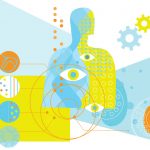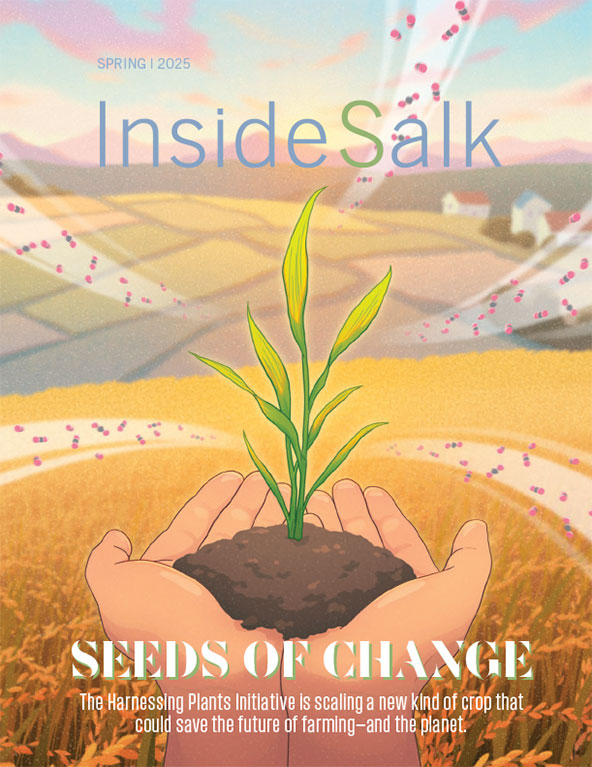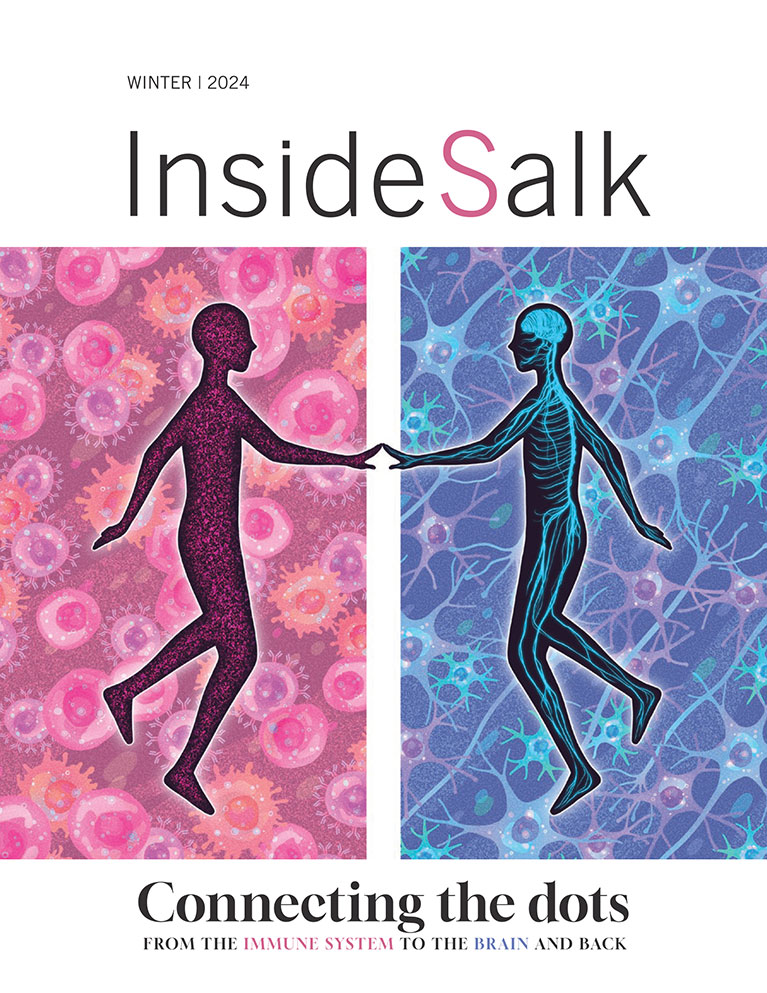A pair of studies from the lab of Professor Satchidananda Panda sheds light on the importance of timing to our health. One, led by Panda, co-senior author and visiting scientist Howard Cooper, and staff scientist Ludovic Mure, and published in Science on February 8, 2018, found that the activity of nearly 80 percent of genes follows a day/night rhythm in many tissue types and brain regions. The other, which appeared in Cell Metabolism on February 6, 2018, uncovered how the liver can have such a speedy response to food, making massive shifts in how it breaks down and stores fats and sugars within minutes of a meal. Both discoveries could inform new therapies for obesity and diabetes.
Read News ReleaseDiscoveries
Making new memories is a balancing act
Professor and co-corresponding author Terrence Sejnowski, along with collaborators at the University of Texas at Austin and the University of Otago, in New Zealand, found that connections in the brain not only expand as needed in response to learning or experiencing new things, but that others shrink as a result. The work could shed light on conditions in which memory formation is impaired, such as depression or Alzheimer’s disease.
How the brain tells our limbs apart
Neural regulation by the regions of the spinal cord that connect to the arms and those that connect to the legs are not well understood. A study in mice by Professor Samuel Pfaff, first author Marito Hayashi, bioinformatics specialist Shawn Driscoll and others revealed contrasts in the neurons that underlie these various types of motor control. The results could one day lead to tailored, stem-cell-based treatments for repairing spinal cord injuries.
Read News ReleaseSalk scientists elucidate myriad functions of the protein ERRγ
Researchers in the lab of Professor Ronald Evans published two papers clarifying the functions of the molecule ERRγ (ERR gamma) on energy production and expenditure. First, in Cell Reports on March 6, 2018, Evans, co-senior author Michael Downes, first author Weiwei Fan and colleagues showed that ERRγ helps deliver many of the benefits associated with endurance exercise by activating genes that create more mitochondria (the power houses of cells). This makes ERRγ a potential therapeutic target for conditions with weakened muscles. In Cell Reports on March 13, 2018, co-senior authors Evans and Downes, together with first author Maryam Ahmadian and others, discovered how ERRγ gives “healthier” brown fat its energy-expending identity, potentially offering a new therapeutic target for diseases related to obesity.
Read March 6 News ReleaseRead March 13 News Release
CRISPR genetic editing takes another big step forward, targeting RNA
Helmsley-Salk Fellow and senior author Patrick Hsu, first author Silvana Konermann, and colleagues have created a new genetic-editing tool that targets not DNA, but RNA, and uses it to correct a protein imbalance in cells from a person with dementia. The new Salk tool, called CasRx, opens up the vast potential of RNA and proteins to genetic editing, giving researchers a powerful way to develop new gene therapies as well as investigate fundamental biological functions. They described CasRx in Cell on March 15, 2018.
Read News ReleaseWhere brain cells get their information may determine their roles in diseases
In the striatum, a brain region associated with action control and learning, 95 percent of neurons communicate with outside regions while 5 percent communicate only within the region. Associate Professor Xin Jin, first author Jason Klug and colleagues mapped where information to the 5 percent is coming from and, in the process, clarified the relationship of two types of neurons to psychiatric and sensory/movement disorders, respectively. The communication pathways represented by these two neuron types may offer new drug targets for disorders as diverse as Parkinson’s, OCD, depression and autism.
Read News ReleaseEarly life experiences influence DNA in the adult brain
Research led by Salk Professor Rusty Gage showed that the type of mothering a female mouse provides her offspring actually changes their DNA. The work lends support to studies about how childhood environments affect brain development in humans and could provide insights into neuropsychiatric disorders, such as depression and schizophrenia.
Tumor suppressor protein targets liver cancer
Salk Professor Tony Hunter and colleagues, together with researchers from Switzerland’s University of Basel and University Hospital Basel, discovered a protein called LHPP that acts as a molecular switch to turn off the uncontrolled growth of cells in liver cancer. The tumor suppressor, which could be useful as a biomarker to help diagnose and monitor treatment for liver cancer, could also be relevant for other cancer types. The work appeared in the journal Nature on March 29, 2018.
Read News ReleaseSalk scientists gain insight into neurological disorders
Researchers in the lab of Rusty Gage use myriad strategies to study the cellular underpinnings of neurological disease, from the interactions of a single layer of cells in a dish to those in a 3D brain-like “organoid.” In work published in Cell Stem Cell in May 2018, Gage, first author Anindita Sarkar and colleagues created multiple types of neurons from stem cells to study the connections between brain cells, showing how communication between neurons is altered in people with schizophrenia.
In a paper in Nature Biotechnology in April 2018, Gage, first author Abed Mansour and colleagues reported a new approach to develop more sophisticated organoid models by ensuring they receive sufficient oxygen and other nutrients via transplantation into rodents. The work could yield insights into the development of cures for brain disorders; speed up the testing of drugs; and even pave the way for someday transplanting healthy populations of human cells into people’s brains to replace damaged or dysfunctional tissue.
Organoids reveal how a deadly brain cancer grows
Glioblastoma multiforme (GBM) is an incredibly deadly brain cancer and presents a serious black box challenge. By editing two genes in just a few cells in human cerebral organoids, first author and Senior Research Associate Junko Ogawa and colleagues generated aggressive GBM tumors. This new model could be used to study tumor progression, investigate new drugs or even personalize treatments for patients. The study was published in the journal Cell Reports on April 24, 2018.
Read News ReleaseUnderstanding how DNA is selectively tagged with “do not use” marks
Assistant Professor Julie Law and first author Ming Zhou discovered a small family of proteins that control where in the genome DNA methylation marks (chemical “do not use” signs) are added. Their work on this aspect of genetic regulation is highly relevant for processes that range from normal development to cellular defects and diseases, which can arise due to erroneous DNA methylation patterns in plants and/or humans. Their paper appeared in Nature Genetics on May 7, 2018.
Read News ReleaseBoosting the effects of vitamin d to tackle diabetes
Salk researchers reported a potential new approach for treating diabetes by protecting beta cells—the cells in the pancreas that produce, store and release insulin. Co-senior authors Ronald Evans and Michael Downes, first author Zong Wei, and colleagues showed that using vitamin D in cells and mouse models proved beneficial in treating damaged beta cells. It also provided new insights about gene regulation that could be applied to developing treatments for other diseases, including cancer. Their paper was published May 10, 2018, in Cell.
Read News ReleaseDiscovery reveals how cells try to control levels of key HIV protein
Salk Professor Katherine Jones, first author Muyu Xu and colleagues discovered a small molecule called JIB-04 that destroys the HIV protein called Tat, responsible for revving up the virus. The molecule, while itself too toxic to serve as a therapy for HIV, reveals enzymes in host cells that can potentially target Tat and halt this runaway replication process. The work was published in PLOS Pathogens on May 23, 2018.
Read News ReleaseDecoding the chemistry of fear
The complexity of the human brain makes fear—and its close cousin, anxiety—difficult to study. Associate Professor Sreekanth Chalasani, UC San Diego graduate student and first author Amy Pribadi and colleagues discovered new clues about the mechanisms of fear and anxiety through an unlikely creature: the tiny nematode worm.
By analyzing the responses of worms exposed to chemicals secreted by its natural predator and studying the underlying molecular pathways, the team uncovered a rudimentary fear-like response that has parallels to human anxiety. The work was published in March 2018 in Nature Communications. Such insights may eventually help refine prescriptions for current anti-anxiety drugs and enable the development of new drugs to treat, for example, PTSD and panic disorder.
Featured Stories
 The immune system: a question of balanceThe immune system is a powerful biological force—a liquid organ that permeates our bodies. Diverse immune cells are constantly on patrol, hunting for miscreants to roust: bacteria, viruses, tumors, cellular trash. The immune system keeps us safe in a hostile world...
The immune system: a question of balanceThe immune system is a powerful biological force—a liquid organ that permeates our bodies. Diverse immune cells are constantly on patrol, hunting for miscreants to roust: bacteria, viruses, tumors, cellular trash. The immune system keeps us safe in a hostile world... Rusty GageComplacency has never been part of Fred (Rusty) Gage’s genetic make-up, neither as he has ascended to the ranks of the world’s most renowned neuroscientists nor as he’s taken the helm as President of the Salk Institute...
Rusty GageComplacency has never been part of Fred (Rusty) Gage’s genetic make-up, neither as he has ascended to the ranks of the world’s most renowned neuroscientists nor as he’s taken the helm as President of the Salk Institute... Emily ManoogianWhen Emily Manoogian was growing up, “scientist” wasn’t even on her list of potential careers. First Manoogian wanted to be a Broadway tap dancer; then a gymnast; later, a lawyer; and finally, towards the end of high school, a veterinarian.
Emily ManoogianWhen Emily Manoogian was growing up, “scientist” wasn’t even on her list of potential careers. First Manoogian wanted to be a Broadway tap dancer; then a gymnast; later, a lawyer; and finally, towards the end of high school, a veterinarian.



















































